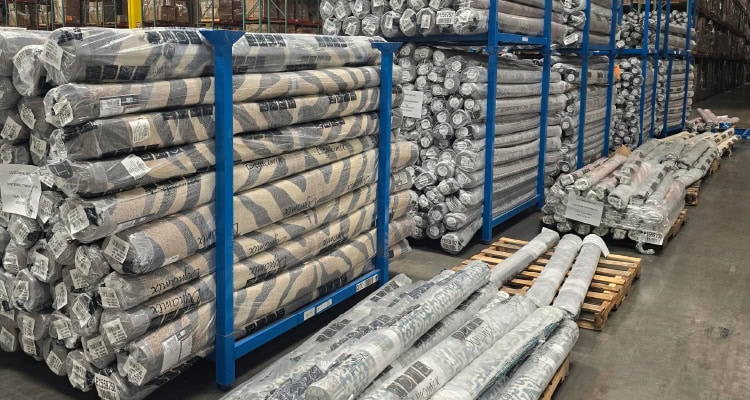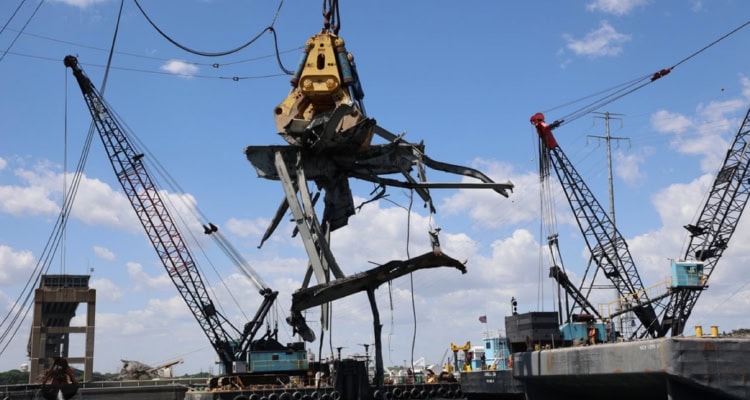Looking to Scale & Flex Your Supply Chain? 3PLs Don’t Toy Around

When you’re ready to play, 3PLs are the hit of the day, making sure supply chains stay scalable, flexible, and resilient.
Supply chains always contend with disruption, but lately there seem to be more booby traps in the road than ever. Delays and shortages born of the pandemic—plus weather disasters, trade wars, shooting wars, inflation, a port-shuttering bridge collapse—all point out the need for resilience in supply chain operations.
Companies often have a tough time dealing with big disturbances. For instance, 67% of supply chain decision-makers responding to a survey conducted by IDC on behalf of supply chain software company Kinaxis said they are not very satisfied with the time their companies take to respond to disruptions.
For many businesses, the key to a resilient supply chain lies in a partnership with a third-party logistics (3PL) service provider. Thanks to their expertise, advanced technology, and close relationships with carriers, 3PLs can help shippers stay flexible and efficient enough to reduce the risk of disruption or, when things do go wrong, to recover quickly.
One of the most sudden recent examples of supply chain disruption came in March 2024, when a cargo ship leaving the Port of Baltimore struck the Francis Scott Key Bridge. The bridge collapsed, killing six workers on the structure and halting ship traffic.
Nexterus, a 3PL based in New Freedom, Pa., had several customers with cargo en route to Baltimore when the port closed. One was U.S. Boiler, which assembles heating systems in Lancaster, Pa., from imported materials and components. Nexterus had just a few days to decide whether to tell the steamship line to divert the company’s containers to Norfolk, New York, or New Jersey.
“We had to look at the individual transportation costs involved in moving freight from those ports to Lancaster,” says Chris Schramm, director of sales and accounts at Nexterus. The calculations included not just the drayage costs, but also the charges Nexterus might incur if it took too long to return the containers to port.
Ultimately, Nexterus sent the containers to New Jersey, making new arrangements to dray them from there to U.S. Boiler’s facility.
“We already had relationships out of the other port, so we were able to have trucking companies grab the freight and bring it to Lancaster, without a significant impact on existing costs,” Schramm says.
Constant Evaluation

Having one 3PL partner manage logistics from end to end helps home textiles company Town & Country Living stay agile and efficient, even when dealing with market uncertainties.
Nexterus doesn’t make such calculations only when emergencies occur. “We’re always evaluating which port offers the best solution for our clients from a cost perspective,” says Schramm.
For instance, drayage costs can fluctuate a great deal based on carriers’ needs. “A lane going to Lancaster out of Savannah, Ga., might be enticing at a certain time of year, because the carrier is trying to do backhauls,” Schramm explains. During that time, it might be more effective to route freight through the Port of Savannah rather than Baltimore.
A broader source of disruption is market volatility. Yesa Yu, strategic clients director at SEKO Logistics in Schaumburg, Ill., points to the way ocean rates soared to $20,000 per container in 2021 and then fell as low as $1,500 in the recent past. “And now there’s an uptick again,” she says.
SEKO helps its customers through those ups and downs by taking a dynamic approach, staying closely in touch with the market and not locking shippers into carrier contracts that promise low rates but don’t guarantee space. “What good is a $1,500 rate if there is no capacity?” Yu asks.
One SEKO customer, Town & Country Living (T&C), which supplies linens, window treatments, and other home textiles to major retailers around the world, has faced special challenges since Yemen’s Houthi militia started to attack ships on the Red Sea.
Those attacks disrupt shipping through the Suez Canal—an important route in T&C’s network. Fewer sailings in that region mean tighter capacity and higher rates.
New York-based T&C manufactures its products mainly in India, Pakistan, Vietnam, China, and Turkey, says Ali Yehia, senior vice president, supply chain and logistics. Product for the U.S. market comes into a central distribution center (DC) in Georgia, about 70% of it through East Coast ports and 30% through the West Coast.
SEKO manages Town & Country’s ocean transportation, drayage to the DC, and transportation to retailers. Having one partner handle logistics from end to end keeps Town & Country agile and efficient enough to deal with uncertainties in the transportation market.
“The SEKO team talks to each other,” Yehia says. “The drayage team coordinates with the distribution center team to understand when we need to ship. We save on lead time—the most important thing—and cost, because we use fewer administrative team employees to manage this communication.”
This coordination also helps prevent performance issues that could trigger chargebacks from retailers, he adds. In a volatile transportation environment, a partner such as SEKO provides a distinct advantage, Yehia says.
“They don’t react to the market; they are a key market player,” he says. “They give us visibility and help us through direct communication and the tools they provide so we can make the proper decisions by reading all the market data.”
More Backup Carriers

Kitchen Cabinet Distributors tripled its warehouse and assembly space in recent years. Through a partnership with 3PL KDL, it improved how it delivers products to customers.
As geopolitical turmoil affects capacity and rates, so does turmoil within the trucking industry. “What if your preferred carrier all of a sudden is unavailable for service?” asks Rob Hammel, co-owner and managing director of KDL Logistics, based in Pittsburgh. “That has happened with a few major carriers.”
Business closures and cybersecurity attacks sometimes knock carriers offline abruptly. Carriers sometimes implement freight embargoes arising from natural disasters or just general overcapacity, making them unable to deliver service.
“When I think of resilience, I try to look at all the angles of what could go wrong and whether we have secondary and tertiary measures in place,” says Hammel. “Redundancies across the supply chain, including a shipper’s portfolio of carriers, are vital for business continuity in the face of unplanned events.”
One way to make sure you can always find capacity is to become a shipper of choice—one that collaborates so effectively with carriers that they offer you the best service and pricing, even when space is tight. KDL helps its customers become more attractive to a wider variety of carriers, giving shippers more flexibility in transportation than they might have otherwise.
“KDL helped us integrate with other carriers that we might not have used before,” says Glen Wegel, vice president of operations and IT at Kitchen Cabinet Distributors (KCD) in Raleigh, N.C.
KCD manufactures wood cabinets in Asia and then ships them in flat packs into four DCs in the United States. From there, it ships product to cabinet shops, contractors, and other resellers.
When KCD improved its packaging to reduce the risk of damage in transit, KDL promoted that fact to carriers. “They also provided us with feedback on things we could do to support carriers and drivers when they come into our facilities,” Wegel says. Those efforts helped KCD connect with carriers that otherwise might not have wanted their business.
KDL has also helped KCD get better pricing. “Carriers traditionally look at a freight profile and quote a price,” Wegel says. But once KDL points out how KCD turns trucks quickly and prevents damage in transit, carriers sometimes offer a better rate.
In addition, KDL helps shippers collaborate with carriers by writing application programming interfaces (APIs) that let data flow freely between shippers’ and carriers’ information systems.
And KDL provides consulting services, pointing out opportunities to increase profits, for example, by choosing different carriers, shipping from different distribution centers, or consolidating shipments to build more cost-effective loads.
“We gather meaningful information, make informed choices, optimize processes, and improve efficiency,” says Eric Elter, vice president of marketing and IT at KDL.
Those services have played a key role in forming KCD’s logistics strategies. “When we looked at domestic freight planning, or bottlenecks, costing, or modeling, KDL was the go-to,” Wegel says.
Who Are You?
One big category of disruption on the radar screen at Jarrett, a 3PL based in Orrville, Ohio, is fraud and identity theft. Criminals who have their eyes on high-value shipments, or on less-costly commodities that are easy to resell, have found ways to pose as reputable carriers, pick up loads, and then drive off with them.
“Theft is at an all-time high,” says Matt Wagner, Jarrett’s chief sales and marketing officer. With so much information about carriers available online, thieves can easily pick up enough information to create fake credentials and pass themselves off as legitimate truckers.
To protect its customers, Jarrett carefully vets the carriers it uses and implements other precautions in house. For instance, it recently formed a partnership with CargoNet, a theft prevention and recovery service.
“We’re able to utilize the knowledge CargoNet has to identify additional new trends and help enhance our internal policies and processes,” Wagner says.
Prevention Training

When supply chain disruptions occur, such as the Francis Scott Key Bridge collapse that closed the Port of Baltimore, 3PLs take action to keep customer freight moving.
Jarrett also teaches shippers how to avert potential fraud. That knowledge came in handy recently when staff at one of Jarrett’s customers detected some suspicious signals from a driver who arrived to pick up a load.
“The staff followed processes that we had helped lay out,” says Wagner. “They asked a lot more questions, based on some new awareness and information. The driver got nervous and ended up leaving.”
While shippers contend with the risk of theft, those who serve retailers may also contend with the risk of customer chargebacks. Penalties for failing to comply with every detail of a retailer’s delivery instructions are perfectly legal, of course. But, like cargo theft, they disrupt the bottom line.
For vendors of consumer packaged goods (CPG) that see a lot of chargebacks from big box retailers, Jarrett conducts analytics to pinpoint what’s triggering those charges. Sometimes the problem lies with a carrier that isn’t hitting required delivery dates. But a performance analysis could also locate failures elsewhere.
Sometimes, for instance, the first delivery appointment a retailer can provide falls after the required delivery date, setting up the shipper for failure no matter what. “The freight was there on time, but they weren’t able to deliver it,” Wagner says. “That’s a consignee exception or failure.”
Sometimes the shipper is at fault for not giving the carrier enough time to make the delivery deadline. Sometimes Jarrett is responsible. “If we create an issue, we hold ourselves accountable,” Wagner says.
By analyzing performance and pinpointing non-compliance issues that were not the shipper’s fault, Jarrett helped one CPG company cut chargebacks by more than 90% over 18 months.
There’s no end to the list of conditions that can interrupt the orderly flow of goods through the supply chain, or add significant, unexpected costs.
“We always have to manage disruptions,” notes Wagner. “And those disruptions always evolve and change.”
Tech Springs Into Action
While the world speculates about how AI could change our lives in the future, 3PLs are already using some aspects of that technology to make their customers’ supply chains more flexible, resilient, and efficient.
“We began implementing our first AI tool in 2019,” says Matt Wagner, chief of sales and marketing at Jarrett, a 3PL in Orrville, Ohio. Today, Jarrett uses AI in several ways.
For instance, it has integrated its proprietary transportation management system with Parade.ai, an AI-fueled application for managing transportation capacity. The goal is to make decisions faster and more efficiently than even highly knowledgeable human operators can do.
“Understanding how to manage carriers, where their footprints are, and what providers may be great opportunities for a specific shipment can help us act faster and more efficiently and improve the client experience,” Wagner says.
Simulation and modeling software help Nexterus, a supply chain and logistics provider based in New Freedom, Pa., keep shippers flexible in the face of all sorts of disruptions, says Ryan Polakoff, the company’s president.
It also helps Nexterus and its partners make strategic decisions, such as where to place distribution centers or how to reduce a company’s carbon footprint, “The ‘what-if’ game has been very busy for us,” Polakoff says.
One newer technology in use at KDL Logistics is the dimensioner, a tool that calculates a load’s density based on its dimensions and weight. Many LTL carriers use density to classify a load for pricing purposes. If a shipper guesses wrong about how its carrier will classify a load, it might undercharge its own customer for shipping and then get a shock when the LTL bill arrives.
“There are tools that can take a scan and get a weight, so they can appropriately charge a freight class,” says Rob Hammel, co-owner and managing director at KDL.
